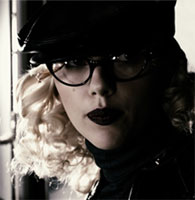Ben Kingsley The Jungle Book
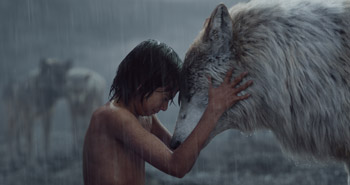
Ben Kingsley The Jungle Book
Cast: Ben Kingsley, Scarlett Johansson, Christopher Walken, Bill Murray, Idris Elba, Lupita Nyong'o
Director: Jon Favreau
Genre: Adventure, Fantasy
Synopsis:
Many strange tales are told of this Jungle.
But none so strange as the tale of the cub we called Mowgli …
~ Bagheera
'The Jungle Book" is an all-new, live-action epic adventure about Mowgli, a man-cub raised by a family of wolves. But Mowgli finds he is no longer welcome in the jungle when fearsome tiger Shere Khan, who bears the scars of Man, promises to eliminate what he sees as a threat. Urged to abandon the only home he's ever known, Mowgli embarks on a captivating journey of self-discovery, guided by panther-turned-stern mentor Bagheera, and the free-spirited bear Baloo. Along the way, Mowgli encounters jungle creatures who don't exactly have his best interests at heart, including Kaa, a python whose seductive voice and gaze hypnotizes the man-cub, and the smooth-talking King Louie, who tries to coerce Mowgli into giving up the secret to the elusive and deadly red flower: fire.
Based on Rudyard Kipling's timeless stories, 'The Jungle Book" is inspired by Disney's classic animated film, with an approach all its own. 'We embrace the mythic qualities of Kipling in the more intense tonal aspects of the film," says director Jon Favreau, 'but we left room for what we remember from the '67 film, and sought to maintain those charming Disneyesque aspects."
Filmmakers employed up-to-the-minute technology to tell the story in a contemporary and immersive way, blending live-action performances with stunning CG environments and extraordinary photo-real animal characters that artists stylized to elevate the storytelling. '-The Jungle Book' is a universal coming-of-age story that everyone can relate to," says producer Brigham Taylor. 'Walt told the story through traditional cell animation and now we have the technology to actually bring these characters to life, make them photo-real and put a real kid into the environment in a seamless, believable way. The opportunity to be able to show that with today's technology was irresistible."
According to Favreau, story is king. 'I think films have to offer an emotional experience for the audience," says the director. 'The spectacle won't mean anything if they're not engaged emotionally with the characters. Every story needs humanity, emotion and character development, as well as humor"presented in a way that doesn't betray the stakes of the film. There are white-knuckle moments in the movie when you wonder, -What's going to happen to this kid?'"
The Jungle Book
Release Date: April 7th, 2016
About The Production
Welcome To The Jungle
Beloved Story Of Man-Cub Mowgli To Touch New Generation
'That's the Mowgli way. That's the Baloo way. That's our way. That's how we get things done."
~ Baloo
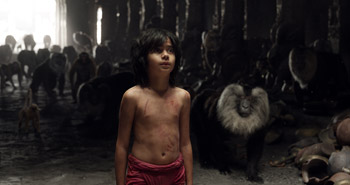 The characters and stories of 'The Jungle Book" have reached people from all parts of the world. Bombay-born, English writer Rudyard Kipling channeled his love of India in 1894's 'The Jungle Book," following with 'The Second Jungle Book" in 1895. Though considered children's books, the stories"with their lush landscapes and talking animals"sparked interest in young and old alike"often introducing readers to India for the first time. Rudyard Kipling, who wrote the stories while starting a family in Vermont, published additional books and short-story collections, and ultimately became the highest-paid writer in the world at age 32. He received the Nobel Prize for Literature in 1907.
The characters and stories of 'The Jungle Book" have reached people from all parts of the world. Bombay-born, English writer Rudyard Kipling channeled his love of India in 1894's 'The Jungle Book," following with 'The Second Jungle Book" in 1895. Though considered children's books, the stories"with their lush landscapes and talking animals"sparked interest in young and old alike"often introducing readers to India for the first time. Rudyard Kipling, who wrote the stories while starting a family in Vermont, published additional books and short-story collections, and ultimately became the highest-paid writer in the world at age 32. He received the Nobel Prize for Literature in 1907.
'Rudyard Kipling's stories follow Joseph Campbell's -hero with a thousand faces' view of mythic storytelling," says director Jon Favreau. 'You have the rise of the hero"a young boy coming of age in the jungle in this environment with all of these archetypal characters. As a filmmaker I find this as very fertile soil."
Rudyard Kipling's stories have been adapted several times in the 12 decades that followed their publication. Directed by Wolfgang Reitherman, Walt Disney Animation Studios' animated movie, 'The Jungle Book," was overhauled when Walt Disney felt that early drafts, which retained the darker tone of Kipling's stories, were too serious. Released on Oct. 18, 1967, a year after Disney's death, the film became a beloved classic. With iconic songs like Terry Gilkyson's 'The Bare Necessities" and the Sherman Brothers' 'I Wanna Be Like You," the film's soundtrack still inspires instantaneous humming and toe tapping today. Disney's 'The Jungle Book" was released theatrically two more times, as well as in-home video, DVD and Blu-ray™ releases, earning fans across generations and rooting Mowgli and his animal friends and foes in hearts around the world.
'The bond between Mowgli and Baloo made a very strong impression on me as a kid," says Jon Favreau. 'It reminded me of my own relationship with my grandfather, who was a big part of my life. I really like that Mowgli is rambunctious, always getting into trouble. He isn't the standard well-behaved kid, but a bit precocious"a -Dennis the Menace' type. He isn't intimidated by these big wild animals, in fact, he's completely at home among them. He's a tough kid but also very vulnerable emotionally, especially with Baloo.
'There was a fun quality to Disney's classic animated version of -The Jungle Book,'" continues Jon Favreau. 'I loved the music and I remember having vivid dreams about the characters. The scenes that made a big visual impression on me"that I am carrying over to this version of film"are images of Mowgli going down the river on the belly of Baloo, the python Kaa with its hypnotic eyes, and the majesty of those elephants marching by."
Like Jon Favreau, producer Brigham Taylor's gateway into the characters and story was his childhood exposure to the animated classic. 'Long before I even knew about the original Kipling works, I saw the Disney animated version. Like most kids, I was deeply impressed by the amazing characters, the wish fulfillment of a kid living in the jungle among the animals. Now, -The Jungle Book' is an elemental and universal story, and its time has come in terms of the technology that we can use for the very first time to tell it in the way that Rudyard Kipling actually imagined: a real kid in a real jungle lives with actual animals that just happen to be able to talk to him."
Filmmakers didn't set out to create a beat-by-beat literal remake of the animated film, nor a total return to Rudyard Kipling's version. Finding just the right tone for this new version of the story was a fundamental priority. Jon Favreau's adaptation of 'The Jungle Book" draws its inspiration from the beloved Disney animated classic, while still retaining the gravitas and mythology inherent in Rudyard Kipling's original stories. 'We're loyal to the animated film's characters," says Brigham Taylor. 'And in other ways, we've taken on some of the realism and tone in Rudyard Kipling's stories. We tend to lean towards the characters that are familiar to us as we experienced them in the animated film, but we do mix and match to serve this version of the story."
Says Jon Favreau, 'We kept going back to the basic idea of Mowgli as a boy raised in the jungle who is forced to leave because of the presence of this big, bad enemy"the tiger Shere Khan. We have Mowgli, who's living a happy-go-lucky life, but doesn't quite fit in a jungle because he's human. Although he's been raised by wolves and lived in the jungle, he doesn't have the physical attributes required to survive in that environment. The jungle"beautiful, with some friendly inhabitants"is a very dangerous place.
'We borrow from Rudyard Kipling in that it's an environment where there's real jeopardy," continues the director. 'It's not safe for a kid. We took the basic story structure of the animated film, but we do it in a way that has higher stakes. We play with a tone that has a lot more jeopardy and where survival isn't necessarily a given."
'It's a coming-of-age story about a kid who is figuring out his place in the world," adds Brigham Taylor. 'The adventure is real, the stakes are high, but at the same time, the film is warm and humane. It's hard to find that combination, but Jon Favreau brings it all to the table."
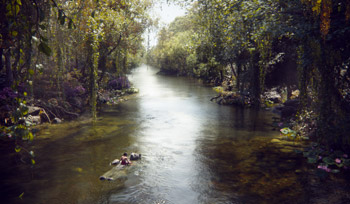 According to Jon Favreau, it's that balance that appeals to viewers of all ages. 'As a parent, I'm so grateful when there's a film that's appropriate for my kids to see but doesn't talk down to them. Kids can keep up with sophisticated storytelling. Walt's dream was always to pull families together"but not necessarily in the most obvious or predictable way.
According to Jon Favreau, it's that balance that appeals to viewers of all ages. 'As a parent, I'm so grateful when there's a film that's appropriate for my kids to see but doesn't talk down to them. Kids can keep up with sophisticated storytelling. Walt's dream was always to pull families together"but not necessarily in the most obvious or predictable way.
'In our version, if you're a Disney fan, you'll notice attention to detail that honors the film's legacy," continues the director. 'If you're a kid seeing -The Jungle Book' for the first time, you might forget to eat your popcorn, because it's going to be a really fun ride."
Who's In The Jungle
Filmmakers Recreate Traditional Characters With A Twist
Poor, sweet little cub. What are you doing so deep in the Jungle?
~ Kaa
Given a roster of memorable characters that won the hearts of many nearly five decades ago, filmmakers wanted to maintain the magic of the familiar faces, while adding a unique spin that promises to win new fans. They called on a charismatic newcomer to play Mowgli, and utilised cutting-edge technology and an all-star voice cast to bring to life his animal counterparts.
According to producer Brigham Taylor, the voice cast"which is like a who's who of Hollywood"was the dream cast. 'I'm happy to be able to say that our cast were all the very first choices that [director] Jon [Favreau] had in mind, which speaks to the pedigree of the project and Jon Favreau's status among the actor community as a director."
'Like a chef needs to use the proper ingredients to prepare the perfect meal, a filmmaker needs the right cast," says Jon Favreau. 'As with all of my films, it always starts with the cast. I have to have a great cast and the right mix of actors, otherwise, I can't do my job properly"especially when you're making a new version of a film that's already so loved."
The characters were brought to life through a combination of voice acting and performances delivered via CG animation. Sometimes, it's difficult to separate the two. Says Brigham Taylor, 'The renderings of some of the characters evolved once the voice actors were cast, sometimes subtly, sometimes a bit more substantially. In all cases, we wanted the animals to look like their counterparts in nature. We want a bear to look like a real bear and a panther to look like a real panther but there were certain subtle, almost imperceptible tweaks to embody the expressions to fit the vocal performances. The animation artists made very clever tweaks that are subtle enough that you still believe in the animal."
Character Lineup
Mowgli is a human boy who was abandoned in the jungle as an infant. A black panther named Bagheera discovers the lone baby and takes him to a wolf pack, who adopts the boy as one of their own. Known in the jungle as the man-cub, Mowgli grows up among the animals"some friends, some foes"never doubting for a moment that he belongs.
'Mowgli is a character who wants to fit in," says Jon Favreau. 'He feels alienated. He's an outsider. A vulnerable little kid, like the ugly duckling in a pack of wolves. Each year the wolf cubs grow and mature faster than him and eventually they get to join the wolf council. He's left behind like that kid in school who gets left behind every year. Although he's a plucky, rambunctious kid with a lot of confidence, his life isn't easy."
Mowgli finds himself lost and confused when he's asked to leave the only home he's ever known. But he's not completely alone. In fact, he's guided by two father figures who contribute opposing views. 'Mowgli's a very loving, accepting character," says Brigham Taylor. 'He accepts Baloo and Bagheera as they are but ultimately he has to synthesize what he's learned from both. Baloo is the character that gives Mowgli the freedom to be who he is and express the talents that he has. Bagheera understands the importance of community, social structure, discipline and working together. By the end of the story, Mowgli is able to borrow a bit from both and he makes it work for him in a way that neither one of them necessarily could see from the beginning."
Filmmakers cast newcomer Neel Sethi as Mowgli. As the only human character to appear on screen, Sethi was called on to not only portray the beloved Mowgli"but to summon incredible imagination skills in order to visualize the other elements in each scene. 'Finding the right kid to play Mowgli was imperative," says Jon Favreau. 'We did an exhaustive worldwide search of 2,000 kids before we found Neel. He was one of the last people that I looked at, and right away, I felt that he had the same emotional and physical qualities that Mowgli had in the '67 animated version. His look was uncanny in how much he evoked what we wanted. He inherently had a good sense of fun and humor."
Adds Brigham Taylor, 'It was an ecstatic moment in casting that I've never experienced before. Neel is one of the fastest learners I've ever seen and Jon [Favreau] is perhaps the best acting coach ever."
The director's coaching skills came in handy since Sethi had never acted professionally. 'Everything in this movie is geared toward the performance of this one kid," says Jon Favreau. 'I've worked with enough kids to be confident in my own taste and my ability to get the performance. He was just so real. He felt right. We knew we found our Mowgli."
Sethi's wardrobe, though limited, was given a lot of thought. 'Our task was to create a loincloth that was both realistic and acceptable," says costume designer Laura Jean Shannon. 'We wanted something organic that would not draw the audience away from the story and the performances. We really wanted Mowgli to evoke the feel of the animated feature of our youth, so we made the loincloth red."
Laura Jean Shannon even developed a backstory for the garment, imagining that as an infant, Mowgli would've been dressed in a traditional Indian dhoti that over time had faded and frayed.
Bagheera is a sleek and stunning panther who rescued Mowgli when he was abandoned in the jungle as an infant. The effort bonded the big cat to the man-cub"indeed, Bagheera has a bit of a soft spot for the boy. As Mowgli's mentor, Bagheera guides him to faithfully follow the laws of the jungle. And when it comes time for Mowgli to leave his jungle home, Bagheera feels it's his duty to help the man-cub depart with dignity.
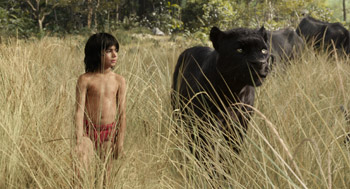 Academy Award® winner Ben Kingsley brings his noble voice to Bagheera. 'He just brought this elegance and refinement to the character, yet with great firmness," says Jon Favreau. 'He's an interesting dude with crazy range."
Academy Award® winner Ben Kingsley brings his noble voice to Bagheera. 'He just brought this elegance and refinement to the character, yet with great firmness," says Jon Favreau. 'He's an interesting dude with crazy range." Says Ben Kingsley, 'Bagheera is Mowgli's adoptive parent. His role in Mowgli's life is to educate, to protect and to guide.
'As an actor," continues Ben Kingsley, 'I have to find my hook into the character. I decided that the role lent itself to the rhythm of the writing if my Bagheera was military"he's probably a colonel. He is instantly recognizable by the way he talks, how he acts and what his ethical code is."
The actor considered the character's physicality when recording. 'When Bagheera is looking back at the story of Mowgli when he was his tutor, I liked to be seated in the recording studio"reclined, very relaxed. I'm telling a story. But when the character is leading him across the jungle, actively protecting Mowgli, I use a much more physical approach toward the microphone. It's quite a disciplined craft."
Ben Kingsley grew up with the source material. 'Rudyard Kipling's stories of Mowgli's adventures with these extraordinary, beautifully defined characters introduce many around the world to the Indian subcontinent and its culture," he says.
The actor was also a fan of the animated film based on Rudyard Kipling's stories. 'I loved the 1967 Disney version," he says. 'I loved the characters, the music."
At its core, says Ben Kingsley, 'The Jungle Book" is about one's search for family. 'There are many wonderful stories that are based on the struggle of an orphan to find a family"to create a family around him, which is a very poignant part of Jon Favreau's version of the film. It will have its beautiful, thrilling, exciting, joyous moments of celebration. But must also quite rightly have its darker moments, because we're dealing with a very isolated child who triumphs over enormous odds."
Raksha, a loving and fiercely protective mother wolf, cares deeply for all of her pups"including man-cub Mowgli, whom she adopts as one of her own when he's abandoned in the jungle as an infant.
'We relied a little more on Rudyard Kipling when it came to Raksha," says Jon Favreau. 'The wolves have a much greater significance in his stories, which was important to me."
Oscar® winner Lupita Nyong'o was called on to help bring Raksha to life. 'I just love my character," says Lupita Nyong'o. 'She is the protector, the eternal mother. The word Raksha actually means protection in Hindi. I felt really connected to that, wanting to protect a son that isn't originally hers but one she's taken for her own.
'I really enjoyed preparing for this and learning about wolves and how social they are, how they stick together," continues Luptia Nyong'o. 'There's such an order"a hierarchy"to a wolf pack. Mowgli tries to fit in with the other wolf pups. He has his challenges, but he is very much a part of the pack as far as Raksha is concerned."
Brigham Taylor credits the actress with channeling her inner wolf. 'Lupita Nyong'o just nailed the emotion of this character, which wasn't really fleshed out in the animated version," he says. 'She intuitively captured that bond between an adoptive mother and her son."
Adds Jon Favreau, 'She's elegant and refined, but it's more than that. She has an accessibility about her that was what we really wanted for Raksha. She feels like a mom, but she clearly comes from somewhere different than where Mowgli does."
Lupita Nyong'o says she was familiar with the story when filmmakers approached her. 'I grew up watching the Disney version and loved it so much," she says. 'As a little girl, my favorite character was Baloo. The magic of Mowgli's story is that every child can identify with that feeling that you are the only one of your kind. I really identified with that idea. And going on an adventure with no adults is the ultimate childhood fantasy. I loved that this kid got to realise himself through this amazing adventure. It's a wonderful coming-of-age story."
Akela is the strong and hardened alpha-male wolf who shoulders the responsibility of the pack. He maintains order, enforces the law of the jungle and serves as a confident chief. He has mixed feelings about Mowgli. Though he's welcomed the man-cub into the pack, Akela harbors a fear that Mowgli will grow up like the unkind humans he's experienced in the past and compromise the safety of the rest of the family.
'Akela is a fierce patriarch of the wolf pack," says Giancarlo Esposito, who voices the character. 'He believes that the strength of the pack lies in what each and every wolf offers. He knows if they stick together, they can survive. He's a great leader, a wise teacher. I aspire to be like him."
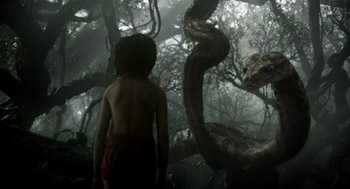 According to Brigham Taylor, Giancarlo Esposito has already achieved that goal. 'Giancarlo is an esteemed actor who absolutely embodies the nature of the character," he says.
According to Brigham Taylor, Giancarlo Esposito has already achieved that goal. 'Giancarlo is an esteemed actor who absolutely embodies the nature of the character," he says. Giancarlo Esposito is a longtime fan of 'The Jungle Book." 'I saw the classic animated version as a kid when it opened in theaters in 1967," he says. 'I enjoyed it so much that it inspired me to read Rudyard Kipling's version. I discovered that Rudyard Kipling wrote such amazing stories that took place in an exotic land."
Bengal tiger Shere Khan bears the scars of Man, which fuel his intense hatred of humans. Powerful and menacing, the fearsome tiger makes no secret of his feelings about man-cub Mowgli and his presence in the jungle. Shere Khan's mission, above all else, is to ensure Mowgli"and the fire he knows Man wields"pose no future threat. Deep down, Shere Khan seeks revenge upon Man, and it's Mowgli who will pay the price.
Golden Globe®-winning actor Idris Elba was tapped to bring the tiger to life. 'Jon [Favreau] and I sculpted what the sound should be," says Idris Elba. 'It was a delicate set of negotiations till we found the right voice."
'Idris Elba wields tremendous presence in a room, which is evident in his voice," says Jon Favreau. 'He's got such gravity and brings his steely presence, a deep timbre that echoes in a larger-than-life way. He understands this scarred, imposing tiger in a way the character demands."
'Shere Khan reigns with fear," says Idris Elba. 'He terrorizes everyone he encounters because he comes from a place of fear.
Idris Elba was shocked when he saw the character come to fruition. 'When Jon [Favreau] showed me Shere Khan's expressions and how he moves, I had to ask, -Is that a real tiger?' The technology is incredible."
Kaa sets her sights on Mowgli when she discovers him all alone in the jungle. The massive python uses her seductive voice and hypnotic gaze to entrance the man-cub, and Mowgli finds himself unable to resist her captivating embrace.
Says Jon Favreau, 'Mowgli is exploring different regions of the jungle"mistier, darker, more mysterious parts of the jungle. That's where Kaa lives. That's where she gets ahold of him"till Baloo rescues him and brings him back to his cave."
The director says one of his most prominent memories of the 1967 animated movie was the snake. 'I always remembered Kaa's hypnotic eyes with the spinning pinwheels," he says.
Though Jon Favreau wanted to maintain the spirit of the character, he decided to change its gender. 'All the roles were male in the 1967 version, so I thought that there was an opportunity with Kaa to mix things up a little bit," says Jon Favreau, who called on Golden Globe® nominee Scarlett Johansson to help bring the seductive snake to life.
'The Jungle Book" marks Scarlett Johansson's third collaboration with Jon Favreau. She originated the role of Black Widow in 'Iron Man 2," and co-starred in Jon Favreau's indie hit 'Chef." 'I remember seeing the movie -Her,' and what an impact Scarlett Johansson made by just using her voice," says the director. 'She has such a presence to her voice."
Says Scarlett Johansson, 'Ever since I was really young, I've loved doing voice work. Actors have different tools"our physical selves, our voices. When you take one of those away you become hyperaware of all kinds of tendencies. It's an interesting process and sometimes you get these happy accidents and ornaments that decorate the performance. It's an exciting way to work and dig deeper.
'For me," continues Scarlett Johansson, 'the opportunity to play Kaa as envisioned by Jon [Favreau] was so exciting. The snake from the animated film is a boy. He's a friendlier, goofier version of the character. In this film, Kaa seduces and entraps Mowgli with her storytelling"her voice. She's the mirror into Mowgli's past. It was thrilling to reinvent this character in this rendering of the story."
The character is designed to be intimidating, yet believable. 'I saw a bit of Kaa early on during the production," says Scarlett Johansson. 'It was important for me to see how she looks in proportion to Mowgli to help inform the presence and intensity of my voice. I had one tool"my voice"so it would've been very difficult without some sort of pre-visual reference.
'Kaa is magnificent," continues Scarlett Johansson. 'The way that she moves is very alluring, almost coquettish. The audience will see this creature through the innocent eyes of this small boy Mowgli"they'll become part of his world."
Scarlett Johansson has vivid memories of the 1967 version of 'The Jungle Book." 'I remember that soundtrack well"it was so popular when I was a kid. -Bare Necessities' was on constant repeat for every kid my age. And the idea of this jungle kid being raised by animals was just fantastic.
'I think little kids can relate to the theme of finding your family"of discovering what it means to be a family," continues the actress. 'The definition of family is such a personal one and families come in all shapes and sizes. But ultimately, family is made up of the people around you who love you unconditionally."
Baloo is a free-spirited bear who meets Mowgli after the man-cub has been banished from the jungle. His bohemian style rubs off on the man-cub, propelling his introspection. 'Baloo is a huge bear, bigger than life," says Jon Favreau. 'He's that teacher that you have in high school that encourages you to read the books that maybe you weren't allowed to read, and opens your eyes to what the world is really all about. He's a subversive thinker. He is not a guy who exactly fits into jungle society. He plays by his own rules and he encourages Mowgli to do the same."
According to the director, Baloo is more complex than meets the eye. 'The trick with Baloo is to capture that avuncular nature that he had in the 1967 film. He was lazy, he liked to eat. But he wasn't a big, cuddly bear. He growled and roared. He knew how to fight and he knew how to protect himself. And still he bonds with this kid"he grows to care about him. Bill Murray was able to preserve those qualities while still bringing his iconic voice to the role."
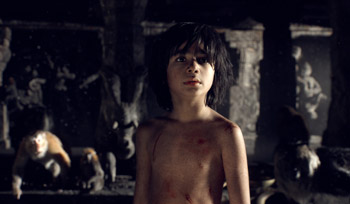 Jon Favreau wanted the Oscar®-nominated actor to voice Baloo from the project's inception. 'He's perfect," says the director. 'Bill Murray just exudes all the charm and humor that you need and expect from Baloo. He has a certain dryness and a rebellious quality.
Jon Favreau wanted the Oscar®-nominated actor to voice Baloo from the project's inception. 'He's perfect," says the director. 'Bill Murray just exudes all the charm and humor that you need and expect from Baloo. He has a certain dryness and a rebellious quality. 'I have always wanted to work with Bill Murray," continues Jon Favreau. 'I'm a huge fan. But he's not the easiest guy to get ahold of. Getting Bill Murray to agree to do your movie is like catching a unicorn. You have to stalk him."
Fortunately for Jon Favreau, the director caught his unicorn. 'It turns out, Bill Murray loves the character," he says. 'Once he came aboard, he was incredibly passionate. He has a very high standard."
'I just couldn't say no to playing Baloo," says Bill Murray. 'Jon [Favreau] is a terrific storyteller and I'm such a huge fan of the original stories. Rudyard Kipling wrote a lot of amazing stuff. I read that book when I was about 22 and I've always thought that it was just extraordinary writing."
King Louie rules over the Bandar-log, a colony of wild and wily monkeys. His stature and prowess make him a formidable force, but he has one great desire: he desperately wants to behold the secret of Man's deadly 'red flower""fire. The massive ape is convinced that Mowgli, who's a man-cub after all, possesses the information he seeks, and King Louie slyly employs his smooth-talking ways in an attempt to coerce Mowgli to give it up.
'Anyone who controls the red flower can control the jungle," says Jon Favreau. 'It's a magical destructive force."
If Mowgli can't give King Louie what he wants, says the director, the ape is likely to reveal his true colors.
Oscar®-winning actor Christopher Walken lends his iconic voice to King Louie. 'It was fun to have Chris Walken play the heavy," says Jon Favreau. 'He's charming and endearing, but there's this unpredictability to him."
Filmmakers rethought the look"and species"of King Louie. 'There are no orangutans in this part of the jungle, so we had to make a leap from the animated film," says Jon Favreau." According to Indian legend, a Gigantopithecus is like a jungle version of a yeti"an elusive character. We exaggerated his height and size even more"he's a fantasy character, so we pushed it."
Especially helpful in the technological efforts behind King Louie's on-screen look, was reference footage. 'We found that with a character like King Louie, who's a primate, we could get a lot of information from a human set of expressions," says Jon Favreau. 'There's nothing a human does with its face that could be translated to a snake's anatomy or a bear"but King Louie benefited."
According to WETA's Dan Lemmon, King Louie"who stands 12 feet tall"was inspired in part by the actor who voices him. 'We used some facial details from Christopher Walken," says Dan Lemmon. 'We studied his performances while recording, as well as other films like -Pulp Fiction' and -True Romance.'
'He has certain peculiarities," continues Dan Lemmon. 'He'll lick his lips occasionally when he's talking and there's something specific about his lower lip. King Louie is definitely a fun character."
Christopher Walken has history with the original voice of King Louie: Louis Prima. 'When I was a kid"underage"I used to go to the Copacabana," says the actor. 'One of the recurring acts at the Copacabana was Louis Prima and Keely Smith. -I Wan'na Be Like You' became his signature."
Building The Jungle
Artists Tap Latest Filmmaking Technology
The elephants created this Jungle … They made all that belongs. The mountains, the trees, the birds in the trees. But they did not make you. That is why you must go.
~ Bagheera
'When I think about Disney's legacy, I relate to Walt's original dream," says director Jon Favreau. 'Walt Disney's work has influenced my work. He was considered high tech for the time. He was the first person who locked soundtrack with picture, so the characters were perfectly choreographed to the musical score"something that absolutely blew people's minds. Disney was on the cutting edge of technology."
To honor Disney's dedication to technology, filmmakers explored the best way to immerse audiences in the world they'd imagined in their version of the story. Says Jon Favreau, 'We asked ourselves, -How can we create a world? How can we use this technology, these storytelling tools to their fullest potential?' Ideally, we wanted the audience to forget that it's technology"they'll just get transported."
Producer Brigham Taylor agrees. 'From a visual perspective, audiences will be immersed in a lush jungle world with all of its danger and peril in a way that's never been seen before. Trying to figure out where the real in-camera elements merge with the digital elements might be fun for some viewers, but I think sooner or later everyone will just forget about all of that because the emotional content of the movie is really engaging. Jon [Favreau] has created a story that is just ripe with emotion and heart."
The film features a cast of captivating characters"all but one are CG creations"amidst a stunning backdrop that blends minimal live-action sets with digitally built environments. Filmmakers assembled a team of experts with movies like 'Life of Pi," 'Gravity," 'Avatar" and 'Guardians of the Galaxy" under their belts, who did extensive research to achieve the authenticity Jon Favreau envisioned, while enhancing reality to give audiences a real adventure.
The key to achieving the right balance was to begin with story. Once the story was hammered out, artists were called on to conceptualize the film beat by beat with an eye toward achieving the photo-real look Jon Favreau desired. By boarding the project first, artists were able to design a workflow, a system and VFX pipeline that could capitalize on the very latest iteration of movie magic, which would allow his director the freedom to push the limits of what's possible in filmmaking. Says Jon Favreau, 'We take the best of the photo-real animation process, the best motion-capture techniques and the best of live-action shooting and combine these three things in a way that nobody's done before. We discovered that we could use cutting-edge technology to create something that appears completely realistic and organic to the audience.
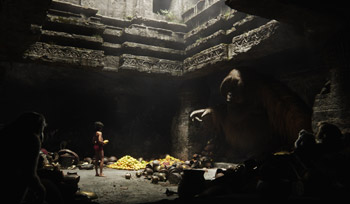 'If you want believability, the physics must be real," the director continues. 'Mowgli and the designs are executed in a real way, but we took a tremendous amount of liberty when we made the jungle. Not unlike Disneyland, we realised that we could make the animals a little bigger than life to help accentuate how vulnerable this little boy feels in the jungle. Every corner of the screen is filled with tremendous detail. We have this beautiful, lush jungle canopy and you have the art direction and the cinematography that's evocative of the old multiplane camerawork from the animated films."
'If you want believability, the physics must be real," the director continues. 'Mowgli and the designs are executed in a real way, but we took a tremendous amount of liberty when we made the jungle. Not unlike Disneyland, we realised that we could make the animals a little bigger than life to help accentuate how vulnerable this little boy feels in the jungle. Every corner of the screen is filled with tremendous detail. We have this beautiful, lush jungle canopy and you have the art direction and the cinematography that's evocative of the old multiplane camerawork from the animated films." Filmmakers employed a virtual camera"a camera that could go anywhere, but didn't. 'We grounded our camera movements in reality," says visual effects supervisor Robert Legato. 'The camera only went where a live-action crane, a Steadicam or a handheld could go. We didn't do crazy flying shots that are absolutely impossible in real life."
The process required an extensive collaboration between teams headed by Legato and animation supervisor Andrew R. Jones, who worked with production designer Christopher Glass; Digital Domain's motion capture team; visual effects supervisor Adam Valdez and his Moving Picture Company's meticulous rendering of the jungle's many animals; and WETA's visual effects supervisor Dan Lemmon, who primarily oversaw the creation and rendering of the primates.
'It's a photo-real film grounded in the real world," says Robert Legato. 'There's something very interesting about that. The biggest challenge is that all of us"including the audience"are experts about what real animals look like. In our film, they're in the same frame with a real boy. We had to resist the urge to be too cinematic. We had to hold back and keep reality top of mind."
Filmmakers employed cutting-edge CGI to create the animals' performances. 'Digital animals are a fascinating realm," says Jon Favreau. 'Films like -Life of Pi' and -Dawn of the Planet of the Apes' started to show biological forms and fur in ways that are indistinguishable from reality. For -Iron Man,' we had to simulate hard metal surfaces in a convincing way. But organic elements"skin and fur"are much more difficult to do. We couldn't have pulled this off just a few years ago"not to the extent that we are doing it now."
Their research was extensive. Artists looked at videos and pictures, read books, visited zoos, consulted animal experts and acted out the movement of animals themselves. 'Footage of animals in the wild, in the proper sunlight, is our basis and foundation for reality," says Andrew Jones. 'Photographic real references of animals are our backbone and starting point. We then slightly tweaked some of the renderings of the animals based on the voice actors' performances, but never to the point of crossing the line into becoming cartoony."
One of the techniques utilised in their pre-visualization efforts was motion capture. The technology wasn't used to capture human performances that will be seen on the big screen, but as a blocking tool. 'Mo-cap is important because it provides a live-action visual for artists to pre-visualize the movie virtually," says Bingham Taylor. 'During the pre-production phase, we put mo-cap actors alongside Neel Sethi on the stage and Jon [Favreau] was able to direct them. The result is a nice pre-visual file that we could edit together and understand the spatial relationship and the performances before we even started shooting in live action."
More than 70 CG animal species were created from scratch for the film, including the iconic characters that take center stage"Baloo, Bagheera, Kaa, Shere Khan and Mowgli's wolf family"plus hundreds of primates, including King Louie and the Bander-log"the army of monkeys populating the Seeonee jungle. New programs were built to simulate muscles, skin and fur, while artists strived to include even the subtlest behaviors from real-life animals to ensure believability. 'Each animal has a unique emotional language," says Jon Favreau. 'A tiger expresses anger much differently than a wolf or a bear would."
According to Adam Valdez, the fantasy the story offers rooted the effort. Artists recognized an opportunity to give audiences the wish fulfillment of living with animals. 'The world and characters needed to pass the test of unblinking believability," says Adam Valdez. 'We had to create an experience that was charming like the classic animated film, but intense when the story needed it.
'Our jungle was the stage for primal mythology," continues Adam Valdez. 'It's not a fairytale. But watching the final scenes is magical in a way."
Real World
In lieu of matching CG environments to an actual jungle, filmmakers decided to build an almost entirely digital jungle. 'We found we were able to exaggerate and enhance certain elements like scale," says Jon Favreau. 'We can take foliage from India's jungles and heighten certain colors. But it's all rooted in reality."
Artists at MPC's Bangalore, India, studio took 100,000 photographs of real locations, creating a massive library of resource material that was matched to the finest details. The result is authentic-looking moss, bark, rock and water. Says Adam Valdez, 'The audience will feel as if they can reach out and touch this environment. Each scene is handcrafted plant by plant, detailed down to thousands of scattered broken leaves, and vines that grow across the landscapes. There are rushing rivers, mudslides and grasses blowing in the wind. Contributing to 80 percent of the frame 100 percent of the time, the jungle itself is the single biggest creation in the film."
According to Christopher Glass, there are several different environments created for the film. The story takes audiences on an adventure"kicking off at the wolf den, where Mowgli grew up, traveling with the man-cub to Kaa's dark and lush jungle digs, and Baloo's colorful world that's more reminiscent of the animated film. King Louie's temple"inspired by a real Indian temple"represents Mowgli's first encounter with man-made structures. 'It's a very significant moment in the movie," says Christopher Glass. 'He sees images of humans for the first time carved into the rocks"there are metaphors on many levels."
The backdrops were deliberately diversified, says Christopher Glass, to illustrate Mowgli's grand journey. Filmmakers were inspired by real Indian environments"but following in Mowgli's footsteps wouldn't be easy. 'He may travel 15 miles total," says Christopher Glass. 'But the areas that inspired our designs might be 700 miles apart. It encompasses the full flavor of India."
Says Robert Legato, 'The audience will feel the grandeur of the Indian jungle. They'll experience this exotic land. That's part of the fun of going to the movies"seeing a place you've never seen before. Living it. Walking through it."
Mowgli In Action
The extensive pre-visualization work was essential, particularly considering that the film's human character, Mowgli, touches and interacts with the environment he's in. Designers built practical sets"creating only what was needed for a particular shot"that was later blended with the CG environment. 'It's never really been done this extensively," says Jon Favreau, 'in every scene"in every shot. We could look at the monitor and see the virtual set we'd already built and how it married perfectly into that environment. We could move the camera and see off into the distance"we could see every mountain and tree that was supposed to be there."
Christopher Glass was charged with creating practical sets that would blend seamlessly into the digital sets. 'The biggest challenge was deciphering which parts of the set we'd need to build," says Christopher Glass. 'That's where the mo-cap version of the movie really served its purpose. We could see where Mowgli's footfalls would be, what he touched. That all dictated what we built for the actual shoot."
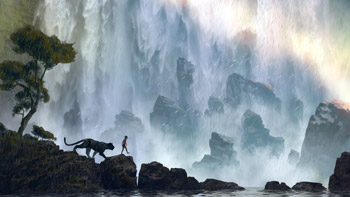 To create the iconic float-down-the-river scene, filmmakers built two tanks with jets and pumps. 'The larger tank had gigantic jets that created a current," says Christopher Glass.
To create the iconic float-down-the-river scene, filmmakers built two tanks with jets and pumps. 'The larger tank had gigantic jets that created a current," says Christopher Glass. Each set had to be constructed with an eye for the digital characters who would be added to the scene. 'We had to be cognizant of where the animated characters were, because if we put a plant right where Baloo was walking, we'd have a problem"we wouldn't capture his interaction with it. On the other hand, we tried to put as much as we could around Mowgli so that he had a lot of interaction with the environment."
Every choice was made with the audience in mind, says Jon Favreau. 'The audience has to be taken on a ride. They want thrills, adventure, excitement, laughs. And they want emotion. I tried to make a movie that I'd want to see."
Old-School Talents Solve High-Tech Challenges
Filmmakers Call on Renowned Puppeteers to Fuel Live-Action Performance
Because the Jungle is no longer safe for you. You're being hunted by a tiger. Only Man can protect you now.
~ Bagheera
Newcomer Neel Sethi's personality and natural abilities helped him win the role of Mowgli, opposite a roster of A-list performers. But as the only live-action actor in the film, Neel Sethi faced a unique challenge: he would be unable to play off his co-stars' performances, which were being assembled digitally. 'We knew that we needed realistic emotional depth to Neel Sethi's performance," says producer Brigham Taylor. 'You can't get that kind of acting against something inanimate, so [director] Jon [Favreau] came up with the idea of always having some performers, ones who will never be seen in the final film, on the stage with Neel. It was either Jon himself and or one of five puppeteers. Neel was always reacting and interacting with someone live so he knew where to focus."
Filmmakers employed puppeteers from Jim Henson's Creature Shop to keep the scenes fresh for Neel Sethi. On set, against a sea of blue screen, the puppeteers synced their actions to vocal tracks that were recorded by the voice actors.
Says visual effects supervisor Robert Legato, 'Sure, you could put a tennis ball on a stick, but it's not the same. There's a palatable chemical reaction when you see somebody smile or change his expression when you say something. A tennis ball can't trigger responses like a master puppeteer who is used to dealing with kids and eliciting emotions."
Robert Legato adds, 'Sometimes a puppeteer would have little eyeballs on his hand and sometimes a huge life-size puppet. We'd change it up from take to take to keep it fresh for this young kid who wasn't a seasoned actor. It helped him give a really great performance."
'Those magic moments happened on a daily basis," adds Brigham Taylor.
Henson veteran puppeteer Artie Esposito portrayed Baloo during live-action shooting. But his work, and that of his fellow puppeteers, will not be seen by audiences. Says Esposito, 'We gave Neel [Sethi] an acting partner on set, and provided eyelines that helped the animation and VFX departments estimate the physical space that the animals inhabited so they fit seamlessly within the frame that was composed."
Sounds Of The Jungle
Veteran Composer John Debney Creates Winning Score
A man-cub becomes Man, and Man is forbidden.
Shere Khan
With its roots in classic Disney animation, Jon Favreau's epic, live-action version of 'The Jungle Book" called for a powerful score. Veteran composer John Debney brought his award-winning sensibilities to the film"along with a notable history as part of the Disney family.
'I have quite a history with Disney," says John Debney, whose father Louis Debney was hired by Walt Disney himself in the mid-1930s. 'When I was a youngster, they were making this incredible magical film called -The Jungle Book,' and I was sort of a studio brat. I got to know the young man Bruce Reitherman who played Mowgli. We would go on adventures around the world with his family."
Fast-forward a few decades, John Debney grew up to become an award-winning composer, scoring films ranging from 'The Passion of the Christ" to Favreau's 'Iron Man 2." According to John Debney, the plan from the get-go was to create a classic score reminiscent of the 1967 film. 'Jon [Favreau] wanted a timeless sound to the score and I embraced that," says the composer. 'That's where I come from. I love writing really rich, beautiful Disneyesque music."
According to producer Brigham Taylor, unlike the original film, the new version is not a musical. 'The animated film is definitely musical comedy and our version is an epic adventure," he says. 'But we all felt that without a nod to the original music, it just wouldn't be correct."
Jon Favreau wanted to pay homage to the original in a subtle way. 'We were able to reinterpret and highlight snippets of the songs we all know and love," says John Debney. 'I couldn't believe I'd get to work with Dick and Bob Sherman's music. I think it's really smart to embrace these amazing, classic tunes"yet bring them into this new interpretation of the story in our own way."
John Debney created a unique theme for Mowgli. 'It's not overly emotional," he says. 'It has an elegance and majesty to it. He's becoming a man through this whole experience and that's what we wanted to say with his theme."
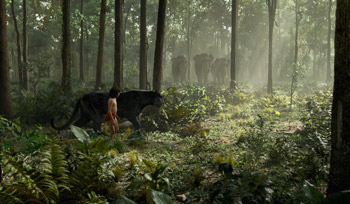 Fearsome tiger Shere Khan was also given a theme"a three- or four-note motif, says Debney"with low brass and strings to illustrate the idea that he's always lurking nearby. Bagheera doesn't have his own theme, but is represented by stately sounds"French horns and strings. Kaa's music, inspired in part by the voice work of Scarlett Johansson, is dark with snakelike sounds. King Louie features low-end percussion instruments, bass marimbas, synthetic wind textures and contrabass bassoons. And Baloo is represented by a fun New Orleans-style sound. 'It's frolicking and emotional," says John Debney. 'Baloo called for quirky strings and bass."
Fearsome tiger Shere Khan was also given a theme"a three- or four-note motif, says Debney"with low brass and strings to illustrate the idea that he's always lurking nearby. Bagheera doesn't have his own theme, but is represented by stately sounds"French horns and strings. Kaa's music, inspired in part by the voice work of Scarlett Johansson, is dark with snakelike sounds. King Louie features low-end percussion instruments, bass marimbas, synthetic wind textures and contrabass bassoons. And Baloo is represented by a fun New Orleans-style sound. 'It's frolicking and emotional," says John Debney. 'Baloo called for quirky strings and bass." The score features a classic orchestral sound accented by ethnic instruments, including bass flutes, woodwinds, big drums, Indian violin and Indian flute. An impressive 104-piece orchestra brought John Debney's score to life.
The composer thinks audiences will be fans of the live-action film. 'I feel it's setting a new benchmark in filmmaking," says John Debney. 'I hope people will walk away humming some of the great tunes they knew and maybe one or two new ones. If we're half as memorable as the original then I'll be a happy guy forever."
The Jungle Book
Release Date: April 7th, 2016
Have You Seen This?
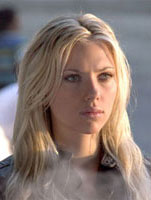
Scarlett Johansson The Island Interview
The beautiful 20-year old Scarlett Johansson runs for her life, as a clone
MORE
- Mission: Impossible Fallout
- Glenn Close The Wife
- Allison Chhorn Stanley's Mouth Interview
- Benicio Del Toro Sicario: Day of the Soldado
- Dame Judi Dench Tea With The Dames
- Sandra Bullock Ocean's 8
- Chris Pratt Jurassic World: Fallen Kingdom
- Claudia Sangiorgi Dalimore and Michelle Grace...
- Rachel McAdams Disobedience Interview
- Sebastián Lelio and Alessandro Nivola...
- Perri Cummings Trench Interview



